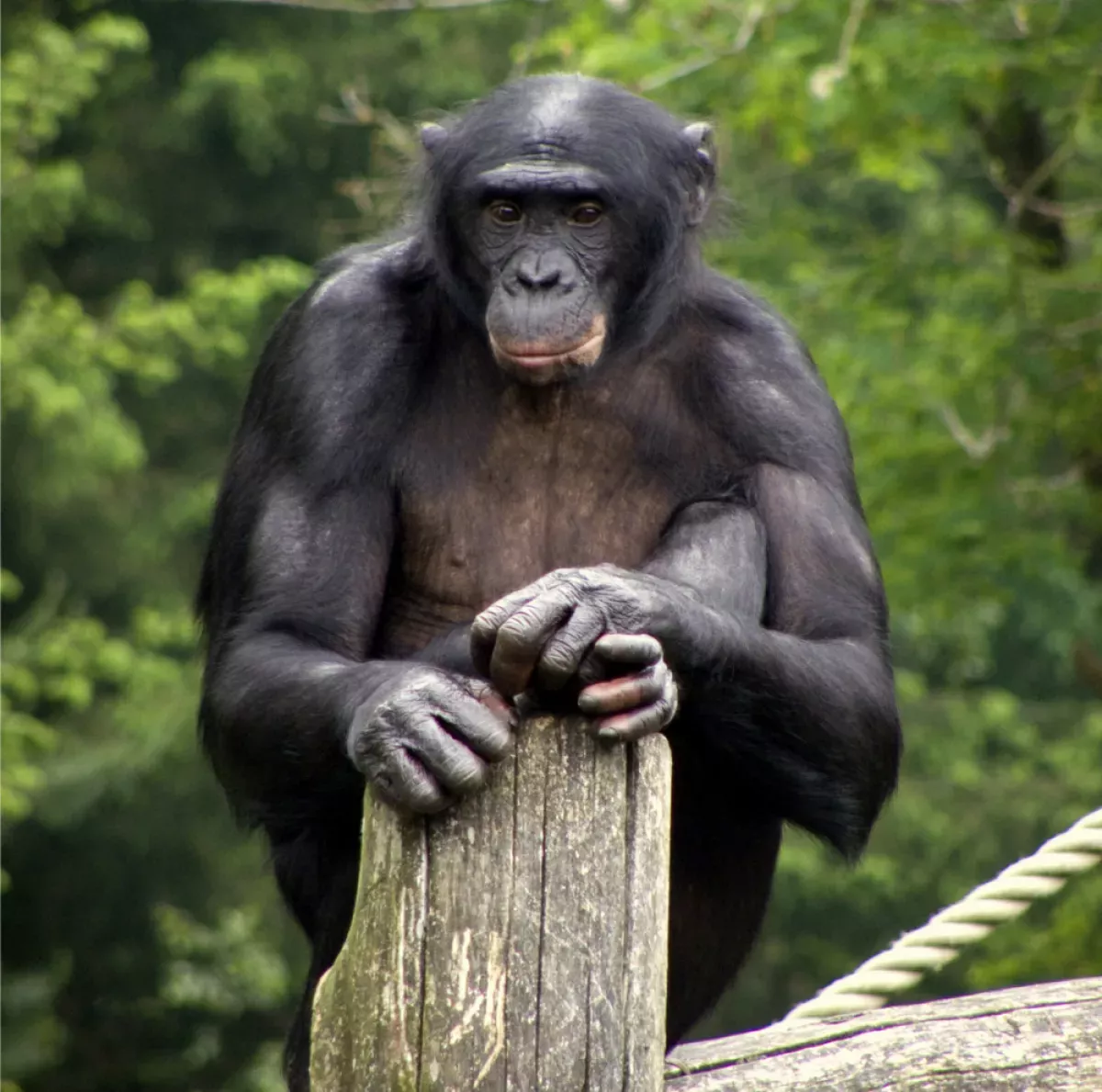The bonobo, formerly known as the pygmy chimpanzee, is an endangered great ape. It's one of two species within the genus Pan, the other being the chimpanzee. Although initially considered a subspecies of chimpanzees due to physical resemblances, bonobos are now recognized as a distinct species. The chimpanzee/bonobo subtribe, Panina, exclusively encompasses the genus Pan and its members are referred to as panins.
1927: Discovery and Geographic Distribution of Bonobos
Ernst Schwarz, in his 1927 paper, announced the discovery of the bonobo, a species found exclusively south of the Congo River, distinguishing their habitat from chimpanzees who reside north of the river.
1928: Bonobo Recognized as a Distinct Taxon
German anatomist Ernst Schwarz identified the bonobo as a separate taxon in 1928, based on a skull misidentified as a juvenile chimpanzee at the Tervuren Museum in Belgium.
1929: Bonobo Classified as a Subspecies of Chimpanzee
Ernst Schwarz published his findings in 1929, categorizing the bonobo as a subspecies of chimpanzee, named Pan satyrus paniscus.
1929: Bonobo Misclassified as "Pygmy Chimpanzee"
German zoologist Ernst Schwarz classified the bonobo as the "pygmy chimpanzee" in 1929 based on a mislabeled bonobo cranium that appeared smaller compared to chimpanzee skulls. Despite having a similar body size to common chimpanzees, the name "pygmy" stuck for a while.
1933: Bonobo Elevated to Species Status
American anatomist Harold Coolidge reclassified the bonobo, elevating it to full species status in 1933.
1954: Origin of the Name "Bonobo"
The name "bonobo" emerged in 1954, proposed by Austrian zoologist Eduard Paul Tratz and German biologist Heinz Heck as a distinct term for pygmy chimpanzees. The name is believed to have originated from a misspelling on a shipping crate from Bolobo, a town on the Congo River near where the first bonobo specimens were collected in the 1920s.
1990: Start of Bonobo-Chimpanzee Hybrid Study
Between 1990 and 1992, a study investigated pregnancies resulting from a male bonobo and two female chimpanzees.
1992: End of Bonobo-Chimpanzee Hybrid Study and Birth of Hybrid Offspring
The study on bonobo-chimpanzee hybrid offspring concluded in 1992. Out of five pregnancies, two were aborted due to stress, but the remaining three resulted in the birth of hybrid offspring.
1995: Publication of the Bonobo Action Plan for Conservation
Driven by concerns about declining bonobo numbers, the Zoological Society of Milwaukee published the "Action Plan for Pan paniscus" in 1995. This plan compiled data on bonobo populations and outlined priority actions for their conservation.
2000: Impact of Poaching and Bushmeat Trade on Bonobos
Surveys conducted since 2000 revealed the devastating impact of poaching and the bushmeat trade on bonobo populations within their range, including Salonga National Park. The findings highlighted the need for community-based conservation strategies to protect the species.
2002: Launch of the Bonobo Peace Forest Project
In 2002, the Bonobo Conservation Initiative launched the Bonobo Peace Forest Project. This project collaborated with local communities to create a network of community-managed reserves to protect the bonobo habitat, covering over 50,000 square miles.
2003: US Government Funding for Congo Basin Forest Partnership
The U.S. government allocated $54 million to the Congo Basin Forest Partnership in 2003, bolstering bonobo conservation efforts. This substantial investment spurred international NGOs to participate in protecting the bonobo habitat.
2005: Discovery of First Pan Fossils
In 2005, the first fossils of the Pan genus, which includes bonobos and chimpanzees, were discovered in Kenya. These fossils, dating back to the Middle Pleistocene (after the bonobo-chimpanzee split), were found alongside early Homo fossils.
2008: Bonobo Hunting Observations
In 2008, researchers Surbeck and Hohmann observed bonobos in Salonga National Park hunting and eating infant monkeys in five separate instances, suggesting deliberate and cooperative hunting behavior.
2008: First Confirmed Case of Wild Bonobo Cannibalism
While there had been disputed claims of bonobo cannibalism in captivity, the first confirmed case in the wild was reported in 2008, describing the consumption of a dead infant.
2010: Differences in Tool Use and Cognitive Skills Between Bonobos and Chimpanzees
Two studies in 2010 found that female bonobos exhibit a wider range of tool use than males, a characteristic previously observed only in chimpanzees among great apes. Furthermore, while bonobos exhibited better social cognition and theory of mind, chimpanzees were more adept at tool use and understanding physical causality.
June 2012: Sequencing and Assembly of the Bonobo Genome
June 2012 marked a significant milestone with the first official publication of the bonobo genome sequence and assembly. The genome, derived from a female bonobo at Leipzig Zoo, was deposited in the International Nucleotide Sequence Database Collaboration (DDBJ/EMBL/GenBank). Preliminary analysis by the National Human Genome Research Institute revealed a 0.4% divergence between the bonobo and chimpanzee genomes.
2012: Publication of the First Bonobo Genome
The first bonobo genome was published in 2012.
2013: Study on Third-Party Affiliation and Consolation in Bonobos
A 2013 study revealed that bonobos, like humans and other great apes, demonstrate third-party affiliation, where a bystander consoles or supports the victim of aggression. Both spontaneous and solicited affiliation reduced further aggression, but spontaneous affiliation proved more effective in reducing victim anxiety, suggesting an empathy-driven consolation behavior in bonobos.
2014: Study on Aggression Levels in Bonobos and Chimpanzees
A 2014 study found that bonobos exhibit less aggression than chimpanzees, particularly eastern chimpanzees. The study suggested that the relatively peaceful nature of western chimpanzees and bonobos could be primarily attributed to ecological factors.
2016: Additional Instances of Bonobo Infant Cannibalism
In 2016, a paper reported two more instances of infant cannibalism among bonobos, although it was not clear if infanticide was involved.
2017: Study on Bonobo, Chimpanzee, and Human Lineage Split
A 2017 study by researchers at The George Washington University indicated that bonobos and common chimpanzees diverged from the human lineage roughly 8 million years ago. The study also suggested that bonobos split from the common chimpanzee lineage around 2 million years ago.
2017: Bonobo-Chimpanzee Hybrid Featured in Film
A hybrid bonobo-chimpanzee named Tiby was featured in the 2017 Swedish film "The Square".
2017: Study on Bonobo and Human Lineage Split
In 2017, researchers at The George Washington University published findings indicating that the ancestors of the genus Pan, which includes bonobos and chimpanzees, diverged from the human lineage around 8 million years ago. Furthermore, the study suggested that bonobos split from the common chimpanzee lineage approximately 2 million years ago.
2017: World Bonobo Day Established
In 2017, the African Wildlife Foundation established February 14th, Valentine's Day, as World Bonobo Day.
2020: First Whole-Genome Comparison Between Chimpanzees and Bonobos
Published in 2020, the first whole-genome comparison between chimpanzees and bonobos revealed genomic differences that could explain their behavioral and evolutionary divergence. This includes differences in genes related to diet and hormones.
2021: Availability of a High-Quality Reference Bonobo Genome
A high-quality reference genome of the bonobo became available in 2021.
November 2023: First Evidence of Cooperation Between Bonobo Groups
In November 2023, a groundbreaking study provided the first documented evidence of intergroup cooperation among primates, specifically bonobos. The research, conducted in the Congo's Kokolopori Bonobo Reserve, observed two distinct bonobo groups, Ekalakala and Kokoalongo, exhibiting unexpected levels of cooperation. Over two years, researchers documented 95 encounters between the groups, characterized by behaviors like grooming, food sharing, and joint defense against threats. This cooperation challenged existing assumptions about primate social structures. While maintaining separate identities and showing no signs of interbreeding, the bonobos' collaborative actions highlighted a nuanced social dynamic, including strategic alliances for individual gain.
April 2024: Report on Bonobo Aggression
On April 12, 2024, biologists reported findings that challenged previous understanding of bonobo behavior. Contrary to earlier beliefs, the report suggested that bonobos might exhibit higher levels of aggression than previously thought.
Mentioned in this timeline

Valentine's Day observed annually on February th began as a...

George Washington a Founding Father served as the first U...
Kenya officially the Republic of Kenya is an East African...

Milwaukee is the most populous city in Wisconsin and sits...
Belgium officially the Kingdom of Belgium is a country in...
The skull a bony structure protecting the brain is composed...
Trending
2 months ago Six Flags Fright Fest Events: Monster Mash Bash and Spooky Season Festivities

2 months ago Dubai Overtakes New York as Top Destination for the World's Wealthy Elite.
Gaten Matarazzo is an American actor known for his stage and screen work He started his career on Broadway appearing...

2 months ago Kendall Jenner Celebrates Her 30th Birthday with Nude Beach Photos and Bikini Looks

6 months ago John Wall's NBA Return Celebrated, DeMarcus Cousins Adds Humor, Fans Show Love.
23 days ago Druski's comedy: Viral video, 'hatfishing' skit, and hosting Billboard 2025 livestream.
Popular

XXXTentacion born Jahseh Dwayne Ricardo Onfroy was a controversial yet...

Ben Shapiro is a prominent American conservative political commentator media...

Candace Owens is an American conservative political commentator and author...

William Franklin Graham III commonly known as Franklin Graham is...

Stranger Things created by the Duffer Brothers is a popular...
The Kennedy Center Honors are annual awards recognizing individuals and...
